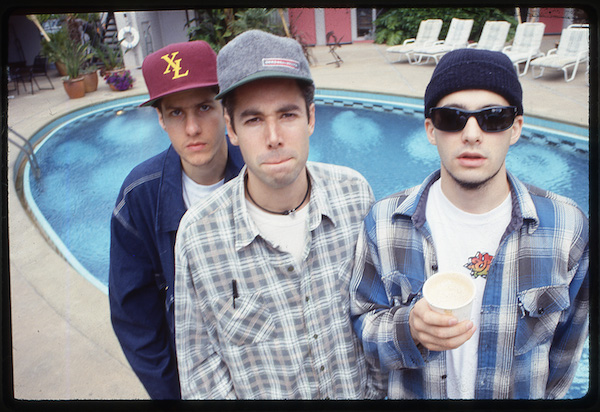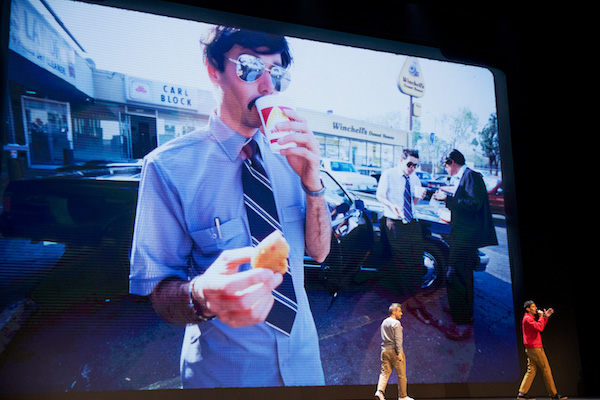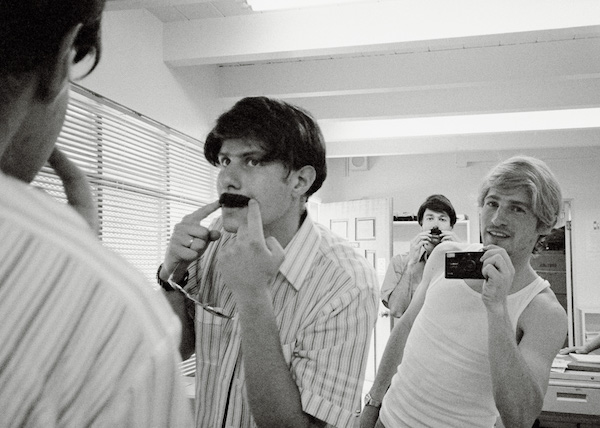Two things stand out in Beastie Boys Story, a concert documentary screening on Apple TV+ starting April 24. First: Adam Yauch got it right. Second: Adam Horovitz is sorry.

Directed by Spike Jonze, Beastie Boys Story is a filmed version of a theater piece Horovitz and Mike Diamond performed at the King’s Theatre in Brooklyn. Backed on a bare stage by projected photos, archival footage, and music videos, Horovitz and Diamond reminisce about their time in one of the world’s biggest rap groups.
Yauch, Horovitz and Diamond started out in the 1980s as punk rockers, along with drummer Kate Schellenbach. Attitude was more important than skill, and in archival clips the group’s DYI energy is infectious, even as Horovitz and Diamond admit their naiveté. Then came rap and MTV.
The Beastie Boys lucked into a friendship with Rick Rubin, who would evolve into an influential, idiosyncratic producer. Rubin introduced them to Russell Simmons, one of the earliest and most successful rap impresarios. Under their guidance, the Beastie Boys became a white rap group, dropping Schellenbach in the process.
Horovitz and Diamond are largely silent about issues like cultural appropriation and sexism, although as director Jonze makes some astute visual juxtapositions highlighting the incongruity of the entire Beastie Boys construct. American culture is riddled with examples of performers like Pat Boone profiting from other cultures. If Russell Simmons “just needed three white rappers to get on MTV,” is he that far from Sam Phillips turning Elvis Presley into a star?

The Beastie Boys’ excuse was that they were just joking. “Our big idea was that we would be as rude and as awful as possible on stage” to get noticed, Diamond says. In their account, the world-wide hit “(You Gotta) Fight for Your Right (to Party!)” was a parody track recorded to fill out the License to Ill album, something that mocked the “party bro and frat guy.” They put a 25-foot penis in their stage act as a test, because they didn’t think they would be allowed get away with it. Funny if it’s a joke, but it turned out many of their fans didn’t get it.
Early tours were by their own admission disastrous, and the group chafed at having to keep up their party bro reputation. (The ironic underpinning to “Fight for Your Right” disappeared pretty quickly.) They wasted money renting a mansion in Los Angeles and recording Paul’s Boutique, a financial failure. Horovitz isn’t too happy about how he responded to fame on a personal level either.
Diamond and Horovitz deliver their bad news with aplomb, bouncing around the stage, trading quips and putdowns, laughing at clips of their earlier selves. Their secret weapon is Yauch, whose development as an artist should be an inspiration to everyone. Yauch became not only a dedicated musician, but a humanitarian who used his celebrity to help others.
Yauch’s growth lets Horovitz and Diamond off the hook to a certain extent, although onstage the two seem genuinely determined to be better, more mature versions of their earlier selves. “It’s not so much that we grew up, but we wised up,” Horovitz says.
He also delivers an endearing riposte: “I’d rather be a hypocrite than the same person forever.” Getting away with it — with being punks, with lacking talent and training, with having no corporate support — was a large part of the Beastie Boys’ appeal.

That and their music, packaged expertly in videos of startling originality (“Sabotage” directed by Jonze himself). The fact that Yauch died of cancer in 2012 gives the entire documentary unexpected gravity.
Beastie Boys Story was originally planned as a theatrical release until COVID-19. It’s streaming now on Apple TV+, but ideally it should be seen in a theater crowded with fans. Maybe that will happen someday.


